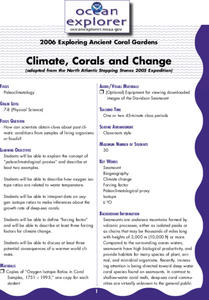Curated OER
The Galapagos Spreading Center
High schoolers explore the basic concept of seafloor spreading. They describe the processes involved in creating new seafloor at a mid-ocean ridge. They investigate the Galapagos Spreading Center system.
Curated OER
Corrosion to Corals
Students study galvanic exchange and how it produces electric currents. In this ocean instructional activity students predict what metals deteriorate in salt water.
Curated OER
Deep Lights
Students investigate materials that emit light. In this deep ocean lesson, students compare and contrast materials that emit light under certain conditions and infer the light-producing process. They explain three ways this evidence is...
Curated OER
Hudson Canyon Expedition; Fishy Deep Sea Designs!
Students explore the physical location of deep water habitats along the Hudson Shelf Valley and in Hudson Canyon. They study the basic characteristics of the mesopelagic and bathypelagic zones with regard to depth, temperature, pres
Curated OER
Adventures of Lewis and Clark Lewis and Clark Journal
Eighth graders experience the Lewis and Clark expedition. For this Corps of Discovery lesson, 8th graders research details regarding the expedition in order to complete a classroom project that requires them to create journals that might...
Curated OER
Explorers
In this explorers learning exercise, students read a detailed text about the Age of Exploration from 1450 to 1700. Students then answer 7 matching or multiple choice questions.
Curated OER
Big Fleas Have Little Fleas
A benthic habitat hosts a vast collection of organisms and its structure influences the biodiversity. Middle-school marine biology explorers will discuss how corals impact structure, and therefore diversity, on the ocean floor. They draw...
NOAA
Climate, Corals and Change
Global warming isn't just an issue on land; deep ocean waters are also showing troubling signs. Young scientists learn more about deep water corals and the many recent discoveries researchers have made. Then they examine data related to...
Curated OER
What's for Dinner?
View a video presentation comparing chemosynthesis to photosynthesis. Review the findings of the 2004 Ring of Fire Expedition that studied biological communities around the hydrothermal vents of the Mariana Arc. In...
Curated OER
Explorations of Lewis and Clark
Students research the Louisiana Purchase. Groups of students are given the choice of topic for a creative project. Pretending to be Lewis and Clark, students write a report to President Jefferson describing their expedition. Other...
Curated OER
The Eyes Have It!
Reading essays about deep-sea expeditions open this lesson on crustacean vision. Marine biology explorers study the compound eye and then complete a worksheet in response to all they have discovered. Although the lesson doesn't offer an...
Institute of Electrical and Electronics Engineers
Telescoping Periscope
Ahoy, matey! Here is an engineering expedition that mini mariners are sure to be swept away by! After reading a brief description and history of periscopes, they work in crews to construct one. Use this activity to enhance a lesson on...
Curated OER
A Differentiated Way through Think Dots
Students examine reasons that led people to explore, identify "West" as defined following Revolutionary War, explain importance of finding natural resources, develop time line of dates and events leading up to Lewis and Clark Expedition,...
Curated OER
The Mission of Lewis and Clark
Students comprehend the various aspects of the Lewis and Clark expediton. They complete an idea web. Students work in small groups. They recall some important aspects of the Lewis and Clark expedition by performing the Corps of...
NOAA
Community Ecology and Sampling
Seamounts in the Coral and Tasman Seas are home to more than 850 different species. Groups explore hydrothermal vents, researching the organisms found there and their energy source. They also learn about seamounts, exploring their unique...
NOAA
Microfriends
Is there medicine found in the organisms that live deep below the surface of the ocean? The fifth lesson plan in a six-part series has learners team up to research bacteria and the relationship it has with nearly every living thing on...
Curated OER
Animals of the Lost City
Begin with a demonstration of exothermic reactions and discussion of chemosynthesis. Your aspiring oceanographers research vent communities and then craft a mural of a vent community. This is a terrific method of introducing learners to...
Curated OER
A Bioluminescent Gallery
Students examine the different types of luminescence in deep sea organisms. In this bioluminescence lesson, students investigate how color and light aide deep ocean organisms by describing the characteristics of the habitat and...
Curated OER
Feeding in the Flow
The National Oceanic and Atmospheric Administration (NOAA) has developed a tremendous library of ocean-themed lessons that can be used in a variety of science settings. "Feeding in the Flow" is one of those activities; Its focus is on...
Curated OER
Entering The Twilight Zone
In this lesson sixth grade students get into groups and research a given ocean habitat. The major features of cold-seep communities are the objective but plenty information is given about other habitats which could be assigned to...
Curated OER
Strange Bugs
As individuals or in small groups, marine biologists research and discuss archaea and their unusual behavior as compared to bacteria. Teach them about the chemical makeup of the cell membrane of these strange organisms. This complex...
Curated OER
I, Robot, Can Do That!
Students describe the three types of underwater robots and the advantages and disadvantages of using them. In this underwater lesson students are given a task and identify the best robot for the job.
Curated OER
Friend, Foe, or . . .
As a result of this lesson, upper elementary ocean explorers will be able to describe several interrelationships: symbiosis, mutualism, commensalism, and parasitism. They learn that the biological richness is increased near seamounts and...

























